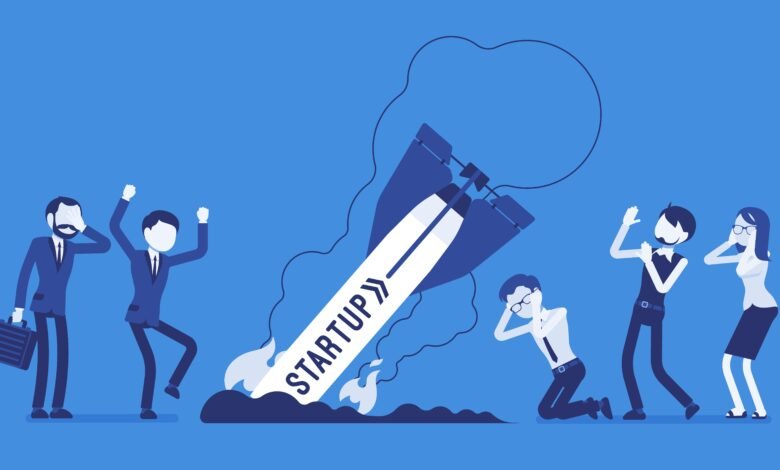AI Startup Failures: Common Mistakes and How to Avoid Them
AI Startup Failures and discover proven strategies to avoid common mistakes. Essential guide for entrepreneurs building successful AI companies

The artificial intelligence startup landscape presents both unprecedented opportunities and formidable challenges. While AI technology promises revolutionary solutions across industries, the harsh reality is that 90% of AI startups fail, with recent studies showing that 95% of AI pilot projects fail to achieve meaningful results. This staggering failure rate isn’t unique to AI alone, but the complexity of artificial intelligence amplifies common entrepreneurial pitfalls.
AI startup failures becomes crucial as we witness a surge of closures in 2024 and 2025. Too many startups built Ferrari-level tech for people still riding scooters, highlighting a fundamental disconnect between technological capability and market demand. The excitement around machine learning startups and generative AI has led entrepreneurs to focus heavily on technical innovation while neglecting essential business fundamentals.
AI Startup Failures in the AI sector often stem from overestimating market readiness, underestimating implementation complexity, and customer needs. 34 percent of startups that fail report a poor product-market fit, while 22% falter because of inadequate marketing strategies. These statistics reveal that even the most sophisticated AI algorithms cannot compensate for flawed business strategies.
The path to building a successful AI company requires more than cutting-edge technology. It demands a deep of market dynamics, customer psychology, regulatory landscapes, and business model sustainability. Entrepreneur advice from industry veterans consistently emphasizes the importance of solving real problems rather than showcasing technological prowess.
This comprehensive guide examines the most common tech startup failures in the AI space, providing actionable insights to help entrepreneurs navigate the treacherous waters of AI entrepreneurship. From product-market fit challenges to funding pitfalls, we’ll explore each critical failure point and present proven strategies for avoiding startup mistakes that have claimed countless AI ventures.
The Current State of AI Startup Failures
The Failure Statistics
The AI startup ecosystem faces unprecedented challenges in 2025. 38% of AI startups fail because they launch products without a market and 54% fail or struggle due to operational challenges. These numbers paint a sobering picture of an industry where technological innovation doesn’t guarantee business success.
Recent market analysis reveals that artificial intelligence startups encounter unique obstacles that traditional tech companies don’t face. The complexity of AI systems, combined with unrealistic expectations from investors and customers, creates a perfect storm for failure. The wave of failures in 2024 underscores the importance of adaptability, prudent financial management, and a relentless focus on product-market fit.
Notable AI Startup Failures in Recent Years
The landscape is littered with once-promising machine learning companies that couldn’t sustain their momentum. High-profile failures include AI-powered trip planning services that had solid technology but failed to find sufficient market demand. McDonald’s withdrew its test AI ordering systems from 100 locations after experiencing significant order errors, demonstrating that even established companies struggle with AI implementation.
These failures share common threads: overestimation of technology readiness, underestimation of integration complexity, and insufficient focus on user experience. Tech entrepreneurship in AI requires balancing innovation with practical application, a challenge that many startups fail to navigate successfully.
Common Mistake #1: Lack of Product-Market Fit
The Product-Market Fit Challenge in AI Startup Failures
Product-market fit represents the most critical success factor for any startup, but AI Startup Failures face unique challenges in achieving it. One of the biggest mistakes AI founders make is overbuilding before they start to achieve PMF. AI makes it tempting to go broad, leading to solutions that impress technically but fail to address specific market needs.
The allure of AI capabilities often causes startup founders to build sophisticated systems that solve problems nobody asked them to solve. This technology-first approach contrasts sharply with successful startups that identify market pain points before developing solutions. Business strategy for AI companies must prioritize market validation over technological demonstration.
Strategies to Achieve Product-Market Fit
Successful AI business models start with narrow, high-impact use cases rather than broad, general-purpose applications. The best AI startup applications begin by solving one, or a narrower set, of high-pain and high-impact problems by automating workflows. This focused approach allows startups to demonstrate clear value and build market traction before expanding.
Startup advice from successful AI AI Startup Failures entrepreneurs emphasizes the importance of customer development alongside technical development. Regular interaction with potential customers helps identify genuine pain points and validates whether AI provides the most effective solution. Many failed startups discovered too late that simpler, non-AI solutions better served their target market.
Measuring and Iterating on Market Fit
AI startup success requires rigorous measurement of customer engagement and satisfaction metrics. Unlike traditional software, AI products need extensive testing to ensure consistent performance across diverse use cases. Successful companies establish feedback loops that capture both technical performance and business value metrics.
Venture capital investors increasingly scrutinize product-market fit evidence before funding AI startups. Companies that can demonstrate measurable customer outcomes and sustainable growth metrics position themselves for long-term success. This data-driven approach to market validation separates surviving startups from those that fail despite impressive technology.
Common Mistake #2: Overestimating Technology Readiness
The Reality Gap in AI Implementation
Artificial intelligence technology often appears more mature in research papers and demos than in real-world applications. Many AI entrepreneurs underestimate the gap between prototype performance and production-ready systems. This miscalculation leads to overpromising capabilities and underdelivering results, damaging credibility with customers and investors.
The complexity of deploying AI systems in enterprise environments frequently surprises startups accustomed to controlled testing conditions. Issues like data quality, integration challenges, and performance variability become apparent only during full-scale implementation. Tech startup challenges in AI include managing these technical risks while maintaining business momentum.
Building Realistic Technology Roadmaps
Successful machine learning startups create conservative estimates for technology development and deployment timelines. They account for data preparation, model training, testing, and integration phases that often consume more time than anticipated. Startup planning should include substantial buffers for technical challenges and iterative improvements.
AI company strategy must balance ambitious vision with pragmatic execution. This means setting achievable milestones that demonstrate progress while building toward larger goals. Investors and customers appreciate transparency about current capabilities and future development plans.
Managing Customer Expectations
Startup marketing for AI companies requires careful communication about technology limitations and capabilities. Overhyping AI performance leads to disappointed customers and damaged relationships. Successful companies educate their market about what AI can and cannot accomplish, positioning themselves as trusted partners rather than miracle solution providers.
Customer success in AI Startup Failures depends heavily on proper expectation setting and ongoing support. Companies that invest in customer education and support infrastructure achieve higher satisfaction rates and lower churn than those that focus solely on technology development.
Common Mistake #3: Insufficient Market Research

Your Target Market
Market research represents a critical foundation that many AI Startup Failures overlook in their rush to develop impressive technology. 22% falter because of inadequate marketing strategies, indicating that technical excellence alone cannot compensate for poor market. AI market analysis must go beyond identifying potential applications to customer behavior, purchasing processes, and implementation challenges.
Successful tech companies invest significant resources in their target customers’ workflows, pain points, and decision-making criteria. AI startups often assume that technological superiority will drive adoption, ignoring the complex human and organizational factors that influence technology adoption. Startup research should focus on customer problems rather than technology capabilities.
Analyzing Competitive Landscape
The AI industry evolves rapidly, with new competitors emerging constantly and established players expanding their AI offerings. Competitive analysis must account for both direct competitors and alternative solutions that customers might choose instead of AI. Many startups fail to recognize that customers often prefer simpler, more reliable solutions over sophisticated AI systems.
Market positioning for AI startups requires not just what competitors offer, but why customers choose specific solutions. This deeper analysis reveals opportunities for differentiation based on customer needs rather than technical features alone. Successful companies position themselves within the broader ecosystem of customer tools and workflows.
Validating Market Size and Demand
Market validation for AI startups involves more than identifying potential applications; it requires demonstrating that customers will pay for AI solutions and can successfully implement them. Many promising AI use cases fail because the target market lacks the infrastructure, data quality, or organizational maturity to benefit from AI technology.
Revenue models for AI companies must account for the extended sales cycles and implementation challenges common in enterprise AI adoption. Startups that understand these market dynamics can plan appropriately for customer acquisition costs and revenue timelines, avoiding the cash flow problems that kill many promising companies.
Common Mistake #4: Poor Financial Management
Funding and Burn Rate Issues
Startup funding for AI companies often comes with inflated expectations about rapid growth and market penetration. Wrong Financial Calculations: Poor forecasts, underestimating costs, and inadequate runway planning represent common pitfalls that lead to premature failure. AI startup investment requires longer development cycles and higher technical costs than many traditional startups.
Burn rate management becomes particularly challenging for AI companies that need expensive computational resources, specialized talent, and extended development periods. Many startups underestimate these costs and run out of money before achieving meaningful market traction. Financial planning must account for the unique cost structure of AI businesses.
Revenue Model Challenges
Business models for AI startups face unique challenges around pricing, value demonstration, and customer acquisition. Unlike traditional software, AI systems require ongoing training, maintenance, and improvement, creating operational costs that continue throughout the product lifecycle. Monetization strategies must account for these ongoing investments.
Pricing strategy for AI products often struggles with the challenge of quantifying value. Customers may be impressed by AI capabilities but struggle to justify costs without clear ROI metrics. Successful AI companies develop pricing models that align with customer value realization rather than technical complexity.
Investment and Scaling Decisions
Venture funding for AI startups peaked in recent years but has become more selective as investors recognize the challenges of building sustainable AI businesses. Governments (US, EU, India) are tightening AI laws in 2025. Startups ignoring compliance (GDPR, copyright, AI Act) will face lawsuits, adding regulatory compliance costs to the growing list of financial considerations.
Scaling strategy for AI companies must balance growth ambitions with financial sustainability. Many startups attempt to scale too quickly, increasing costs without proportional revenue growth. Successful companies prioritize efficient growth that maintains positive unit economics while building market position.
Common Mistake #5: Building Solutions Without Customer Input
The Dangers of Technology-First Development
Customer development often takes a backseat to technical development in AI startups, leading to sophisticated solutions that don’t address real market needs. User-centered design principles become even more critical in AI applications where user experience can make or break product adoption. Many AI products fail because they prioritize algorithmic performance over usability.
Product development in AI requires constant interaction with potential users to understand not just what they need, but how they work and make decisions. AI systems that don’t align with existing workflows and mental models face adoption challenges regardless of their technical capabilities. Startup methodology should emphasize customer feedback throughout the development process.
Implementing Customer Feedback Loops
Customer feedback systems for AI products must capture both functional feedback about features and performance feedback about AI accuracy and reliability. Users may appreciate AI capabilities but struggle with unpredictable behavior or lack of transparency in AI decision-making. Iterative development allows startups to refine both their algorithms and user experiences based on real usage data.
Beta testing for AI products requires more extensive customer engagement than traditional software because AI behavior varies across different use cases and data sets. Successful startups create structured feedback programs that help them understand how their AI performs across diverse customer scenarios and requirements.
User Experience Design for AI Products
UI/UX design for AI applications faces unique challenges around managing user expectations and providing appropriate feedback about AI decisions. Users need to understand what the AI is doing, why it made specific decisions, and how confident they should be in AI recommendations. Design thinking for AI products must address these transparency and trust requirements.
Product usability in AI applications often determines adoption success more than algorithmic performance. Users will abandon sophisticated AI tools that are difficult to use in favor of simpler alternatives that integrate better with their existing workflows. Human-centered AI design principles should guide product development decisions.
Common Mistake #6: Team and Leadership Problems

Building the Right Team
AI talent shortages create significant challenges for startups trying to build effective teams. The competition for experienced AI engineers, data scientists, and machine learning experts drives up compensation costs while making it difficult to find candidates with the right combination of technical and business skills. Team building strategies must account for these market realities.
AI Startup Failure teams need diverse skills beyond technical AI expertise, including domain knowledge, business development, and customer success capabilities. Team issues and financial problems account for 18% and 16% of failures, highlighting the importance of building balanced teams that can execute across all aspects of business development.
Leadership and Vision Issues
Startup leadership in AI companies requires balancing technical vision with business pragmatism. Many AI startups fail because their founders become too focused on technical possibilities without developing clear business strategies. Executive coaching and advisory support can help technical founders develop the business skills necessary for startup success.
Company culture in AI Startup Failures must embrace both innovation and execution discipline. Teams that focus exclusively on research and development without attention to customer needs and market dynamics struggle to build sustainable businesses. Organizational development should emphasize customer focus alongside technical excellence.
Managing Technical and Business Talent
Talent retention becomes particularly challenging for AI startups competing with large technology companies for scarce AI expertise. Compensation strategy must include equity participation and growth opportunities that can compete with established company offers. Team management should focus on creating engaging work environments that attract and retain top talent.
Skills development within AI startups should include both technical training and business development capabilities. Cross-functional collaboration between technical and business teams improves product development outcomes and helps teams better understand market requirements. Professional development investments pay dividends in team effectiveness and retention.
Common Mistake #7: Regulatory and Ethical Oversights
Navigating AI Regulations
AI regulations are rapidly evolving worldwide, with new compliance requirements emerging regularly. Companies like OpenAI now prioritize AI safety and watermarking — survivors will too, indicating that regulatory compliance has become a competitive advantage rather than just a legal requirement. Compliance strategy must be integrated into product development from the beginning.
Legal considerations for AI startups include data privacy, algorithmic bias, intellectual property, and safety requirements that vary by jurisdiction and application domain. Regulatory compliance costs can be substantial and must be factored into business planning and pricing strategies. Startups that ignore these requirements face legal risks and market exclusion.
Addressing Ethical AI Concerns
AI ethics considerations affect customer adoption, investor support, and regulatory approval for AI products. Responsible AI development practices include bias testing, transparency measures, and safety protocols that add complexity to product development but are essential for sustainable business success. Ethical considerations should be integrated into product design rather than treated as afterthoughts.
Bias mitigation and fairness testing require ongoing attention throughout the AI Startup Failures development lifecycle. AI governance frameworks help startups establish consistent practices for ethical AI development while managing the associated costs and complexity. Companies that proactively address ethical concerns build stronger customer relationships and reduce regulatory risks.
Building Trust and Transparency
AI transparency requirements from customers and regulators continue to increase, requiring startups to explain how their AI systems make decisions. Explainable AI capabilities may be necessary for customer adoption even if they add technical complexity. Trust building through transparency becomes a competitive advantage in markets where AI adoption concerns persist.
Safety protocols for AI systems require ongoing monitoring and testing to ensure consistent performance and identify potential risks. Risk management processes should include both technical risks and business risks associated with AI system failures. Quality assurance for AI products requires more sophisticated testing than traditional software development.
How to Avoid These Common Mistakes
Developing a Customer-Centric Approach
Customer-first strategy represents the most effective defense against AI startup failure. This approach prioritizes customer problems before developing technical solutions, ensuring that AI capabilities address genuine market needs. Customer validation should begin before technical development and continue throughout the product lifecycle.
Market-driven development requires regular interaction with potential customers, systematic collection of feedback, and willingness to pivot based on market learning. Customer interviews and user research provide insights that prevent startups from building sophisticated technology that doesn’t create customer value.
Creating Realistic Business Plans
Business planning for AI startups must account for longer development cycles, higher technical costs, and extended customer adoption timelines than traditional software startups. Financial modeling should include conservative revenue projections and adequate buffers for technical challenges and market development costs.
Milestone planning should balance technical achievements with business progress, ensuring that startups maintain focus on customer value creation alongside technology development. Progress measurement should include both technical metrics and business metrics that demonstrate market traction and customer success.
Building Strong Partnerships
Strategic partnerships can help AI Startup Failures overcome resource constraints and access markets more effectively than attempting to build everything internally. Channel partnerships provide access to customer relationships and domain expertise that accelerate market entry and product development.
Technology partnerships with cloud providers, data companies, and complementary technology vendors can reduce development costs and improve product capabilities. Ecosystem development helps startups integrate their AI capabilities with existing customer tools and workflows.
Implementing Proper Validation Processes
Product validation for AI startups requires testing both technical performance and customer value creation across diverse use cases and market conditions. Validation methodology should include controlled testing environments and real-world pilot projects that demonstrate practical value.
Market validation continues throughout product development, with regular reassessment of customer needs, competitive landscape, and market conditions. Continuous validation helps startups identify market changes and adapt their strategies before problems become critical.
Focusing on Sustainable Growth
Growth strategy for AI startups must balance market expansion with operational efficiency and customer success. Sustainable scaling requires systems and processes that maintain product quality and customer satisfaction as the business grows.
Unit economics analysis helps startups understand the true cost of customer acquisition and service delivery, enabling better decisions about pricing, marketing investment, and operational scaling. Profitability planning should begin early in startup development rather than being deferred until later growth stages.
Maintaining Agility and Adaptability
Agile development methodologies prove particularly valuable for AI startups because of the uncertainty inherent in AI system development and market evolution. Iterative improvement allows startups to learn from customer feedback and technical challenges while maintaining development momentum.
Strategic flexibility enables startups to adapt their business models, target markets, and product features based on market learning and competitive dynamics. Pivot strategies should be planned in advance so startups can respond quickly to changing conditions without losing valuable time and resources.
More Read: Why AI Startups Are Disrupting Traditional Industries Faster Than Ever
Conclusion
The journey of building a successful AI startup requires navigating complex challenges that extend far beyond technical innovation. While 90% of AI startups fail, avoiding common mistakes significantly improves survival odds. AI startup success depends on balancing cutting-edge technology with fundamental business principles, maintaining customer focus while developing sophisticated algorithms, and building sustainable business models that create genuine market value.
The startups that survive and thrive will be those that learn from past failures, prioritize customer needs over technical capabilities, and build robust businesses that can adapt to rapidly changing market conditions. By implementing the strategies outlined in this guide—from achieving genuine product-market fit to maintaining financial discipline and regulatory compliance—entrepreneurs can build AI companies that not only survive but become market leaders in the evolving artificial intelligence landscape.











